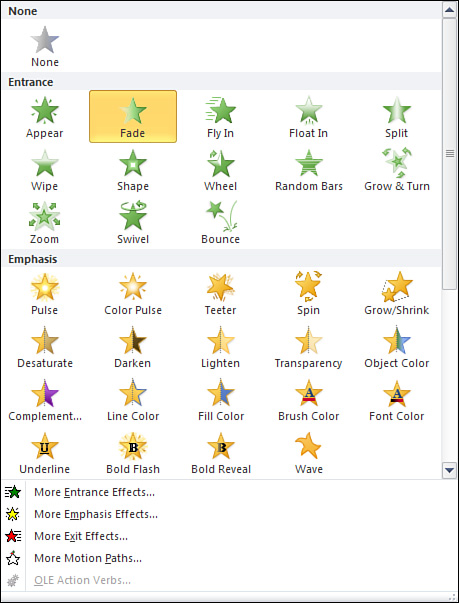You can apply basic animation to objects
such as shapes, text placeholders, text boxes, SmartArt graphics, and
charts using the options available in the Animation group on the
Animations tab, as shown in Figure 1.

Animating Objects
To apply animations to objects, follow these steps:
1. | Select
the object or objects you want to animate. If you select more than one
object, PowerPoint applies the animation to both objects at the same time. If you want the animations to occur in sequence, you must apply animation separately.
|
2. | On
the Animations tab, select the animation you want to apply from the
Animation group. Several options appear on the ribbon, but you can click
the down arrow in the lower-right corner of the group and choose one of
the options that appear in the gallery (see Figure 2).

|
PowerPoint offers four categories of animations:
Entrance— Determine how the text or object enters the slide.
Emphasis— Add emphasis to the text or object.
Exit— Determine how the text or object exits the slide.
Motion Paths— Set a path that the selected text or object follows.
|
Select More Entrance Effects, More Emphasis Effects,
More Exit Effects, or More Motion Paths in the gallery to open a dialog
box with additional options.
|
3. | Click
the Effect Options button to choose the direction to apply the
animation. The options that appear here vary based on the animation you
chose.
For example, if you choose the Fly In animation,
this list includes eight options, including From Bottom or From Right.
If the animation you selected doesn’t offer effect options, you can’t
select this button.
|
4. | Click
the Trigger button to specify what triggers this animation to start.
Your choices include setting triggers based on the click of a specific
object on the slide or on a bookmark.
|
5. | Click the down arrow to the right of the Start button to specify when to start the animation:
- On Click— Start the animation when you click the mouse.
- With Previous— Start the animation when the previous animation in the list starts.
- After Previous— Start the animation after the previous animation in the list finishes.
|
6. | Select
a Delay, in seconds, between each animation. If you don’t want a delay,
select 00.00 in this field. Otherwise, you can specify delays in 0.25
increments.
|
7. | Select
a Duration, in seconds, to determine how long the animation should
last. The smallest duration you can choose is 00.01, which introduces,
and ends, your animation almost instantly. Otherwise, you can specify
durations in 0.25 increments. If you choose a long duration, be aware
that this creates a slow motion effect.
|
8. | Click the Preview button to preview your animation choices.
|